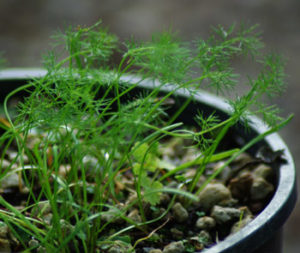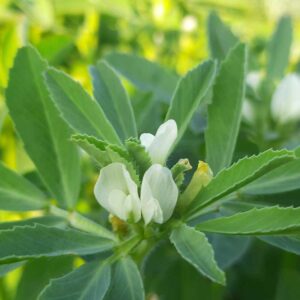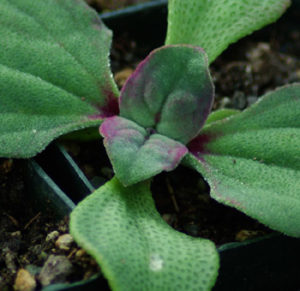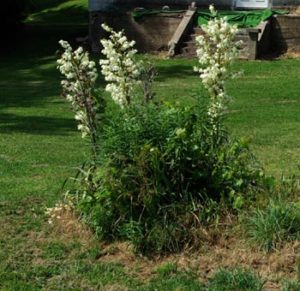Mugwort, Common (Artemisia vulgaris) seeds [NY NO]
Price range: $3.95 through $44.10
Family: Aster (Asteraceae)
Hardy to Zones 3 to 9
(Common Mugwort, Wild Wormwood, Ai-ye) Herbaceous perennial, a vigorous spreader and self-seeder.Plant has soft leaves, pleasantly downy on the undersides. Traditional usage (TCM, TWM): Moxa, circulation stimulant, dream inducing. Plant prefers sun to part shade and will grow in gravel, waste places or regular garden soil. Sow very tiny seeds on surface and tamp in securely. Keep evenly moist until germination, which takes 1 to 3 weeks. Plant 2 feet apart. Grows 3 to 4 feet tall.
Packet contains 200 seeds
1 g contains ~4,000 seeds
5 g contains ~20,000 seeds
10 g contains ~40,000 seeds
Open Pollinated, Untreated, NO GMO’s [Not available to the State of NY]

![Mugwort, Common (Artemisia vulgaris) seeds [NY NO]](https://strictlymedicinalseeds.com/wp-content/uploads/2016/11/Mugwort_500-1.jpg)
![Mugwort, Common (Artemisia vulgaris) seeds [NY NO] - Image 2](https://strictlymedicinalseeds.com/wp-content/uploads/2016/11/Mugwort_plant_500.jpg)




Question
Tim R. (verified owner) –
Do the seeds you send need to be “cold stratified” for the best germination?
Upvote if this was helpful (0) Downvote if this was not helpful (0) Watch Unwatch Flag for removal
Richo Cech –
Hi Tim, No, mugwort is a simple warm soil germinator. Make sure the seed is not buried deeply, and tamp the planting. Richo
Upvote if this was helpful (0) Downvote if this was not helpful (0) Flag for removal
Question
Christen (verified owner) –
I was recently told by another herbalist that you should harvest mugwort for tincturing when it’s 6 inches tall or less in the spring and after that it’s no good for internal use. I tried to look that up in Making Plant Medicine and you didn’t speak to Mugwort soecifically. Under Wormwood you said to harvest in early flowering stage. Woukd you recommend that for vulgaris also (common mugwort)? Thank you for your time and experience.
Christen
Upvote if this was helpful (0) Downvote if this was not helpful (0) Watch Unwatch Flag for removal
Richo Cech –
Hi Christen, Thanks for writing. The best quality herb is harvested during the early flowering stage (page 200 “Growing Plant Medicine Vol 1.”) As the plant grows and matures each season, the resins and essential oils increase, up until seed stage. So, if someone recommends that you use the very young herb, it means they have a concern about excessive activity and are looking for a mild influence. This can also be controlled by means of dosage, especially if reduced to tincture form, in which case dosage can be carefully controlled. Richo
Upvote if this was helpful (0) Downvote if this was not helpful (0) Flag for removal
Question
Cynthia –
Hi There! Can you tell me if this is common mugwort? I bought seeds last year but didn’t appear to get anything to germinate and might have given up too soon. I always throw all seed starting medium in my vegetable garden and this came up this year and was different than anything else. It got to about 3 ft tall but never flowered so I cut it back and planted beets in that bed. These are starting from rhizomes. I hope it’s mugwort😊
Upvote if this was helpful (1) Downvote if this was not helpful (0) Watch Unwatch Flag for removal
Richo Cech –
Hi Cynthis, this is mugwort (Artemisia vulgaris). All these things are going to look a bit different as immature seedlings vs full-blown adult plants. richo
Upvote if this was helpful (0) Downvote if this was not helpful (0) Flag for removal
Question
SUH Seung Ji –
I am trying my hand at making Makgeolli. It says I have to wrap the Koji in mugwort. Doesn’t say if it has to be a certain type. Would this work?
Upvote if this was helpful (0) Downvote if this was not helpful (0) Watch Unwatch Flag for removal
Richo Cech –
i do think this would work. in the european tradition, used in ales, so there is a good comparison there.
Upvote if this was helpful (0) Downvote if this was not helpful (0) Flag for removal
Question
Steven –
Are Chinese use Mugwort Vulgaris to make Moxibustion Moxa ?
Upvote if this was helpful (0) Downvote if this was not helpful (0) Watch Unwatch Flag for removal
Richo Cech –
hi steven, yes, both Artemisia vulgaris and A. princeps are used for this. I think probably other species as well. r
Upvote if this was helpful (0) Downvote if this was not helpful (0) Flag for removal
Question
mieke –
hello, can you ship to new zealand? Thanks ?
Upvote if this was helpful (0) Downvote if this was not helpful (0) Watch Unwatch Flag for removal
Richo Cech –
Due to new, extremely stringent regulations, we cannot successfully ship seeds to: The EU, Montenegro or Scandinavia, the UK, Australia, New Zealand, Arabia, Mexico, Central and South America or Africa. We still ship with some success to: Canada, Asia, and European countries not in the EU.
Upvote if this was helpful (0) Downvote if this was not helpful (0) Flag for removal
Question
Alexandru –
Hi there! I already have a well-established patch of Artemisia absinthum. Should I worry about cross pollination with the mugwort and what would be the result? what is the optimum distance to plant it in this case? thanks a lot!
Upvote if this was helpful (0) Downvote if this was not helpful (0) Watch Unwatch Flag for removal
Admin Richo Cech –
These are different species and will not hybridize.
Upvote if this was helpful (0) Downvote if this was not helpful (0) Flag for removal
Stephanie (verified owner) –
Does this species have as pleasant a smell as ludoviciana?
Upvote if this was helpful (0) Downvote if this was not helpful (0) Flag for removal
Richo Cech –
Hi Stephanie,
Yes, it is pleasant. People make dream pillows from it.
Richo
Upvote if this was helpful (0) Downvote if this was not helpful (0) Flag for removal
Lauren Gormly –
Hello! What is the difference between Artemisia Vulgaris and Artemisia Annua?
Upvote if this was helpful (0) Downvote if this was not helpful (0) Flag for removal
Richo Cech –
Hi Lauren,
The Artemisia vulgaris is mugwort, a perennial plant used by herbalists as a mild gastric stimulant and by dream pillow makers for making dream pillows. The Artemisia annua is an annual Chinese herb used traditionally by herbalists for treating malaria and of interest these days as a potential treatment for COVID. You can find out a lot about this herb by looking on the World Health Organization website or by reading my book “Making Plant Medicine.” Richo
Upvote if this was helpful (0) Downvote if this was not helpful (0) Flag for removal
Marleen Brown –
what does “NY No” mean??
Upvote if this was helpful (0) Downvote if this was not helpful (0) Flag for removal
Richo Cech –
It means that NY has disallowed this species because the authorities there believe it to be an undesirable weed. r
Upvote if this was helpful (0) Downvote if this was not helpful (0) Flag for removal
Alexis –
Hi,do you ship to cyprus?
Upvote if this was helpful (0) Downvote if this was not helpful (0) Flag for removal
Richo Cech –
Hi Alexis, In this day and age, probably not successfully.
Richo
Upvote if this was helpful (0) Downvote if this was not helpful (0) Flag for removal
Prashanti –
i have a artemesia with two colors green and light green, is this the A. Vulgaris?
Upvote if this was helpful (0) Downvote if this was not helpful (0) Flag for removal
Richo Cech –
Hello Prashanti,
Yes, Artemisia vulgaris should have a leaf that is green on the dorsal surface and light green on the ventral surface.
Richo
Upvote if this was helpful (0) Downvote if this was not helpful (0) Flag for removal
Tim Corkern –
Do you ship to Louisiana?
Upvote if this was helpful (0) Downvote if this was not helpful (0) Flag for removal
Richo Cech –
Hello Tim, Yes. Richo
Upvote if this was helpful (0) Downvote if this was not helpful (0) Flag for removal
cz –
Hi how is this differ from artemisia argyi? Which one is used in TCM? Thanks!
Upvote if this was helpful (0) Downvote if this was not helpful (0) Flag for removal
Richo Cech –
hi cz, we don’t have artemisia argyi, although it is as you say similar to vulgaris and also very similar to princeps (yomogi). spell “artemisia” in our search engine and you’ll see several more choices that yes, are used in tcm–annua, scoparia, etc. r
Upvote if this was helpful (0) Downvote if this was not helpful (0) Flag for removal
Nora –
This grows wild all around my Creekside backyard and it’s lovely. I’ve used it to smudge andI have read it deters caterpillars (who are eating my roses.) have you had any luck using it in a pot near rises to protect as a companion?
Upvote if this was helpful (0) Downvote if this was not helpful (0) Flag for removal
Richo Cech –
Hi Nora, No, my go-to is neem seed meal. richo
Upvote if this was helpful (0) Downvote if this was not helpful (0) Flag for removal